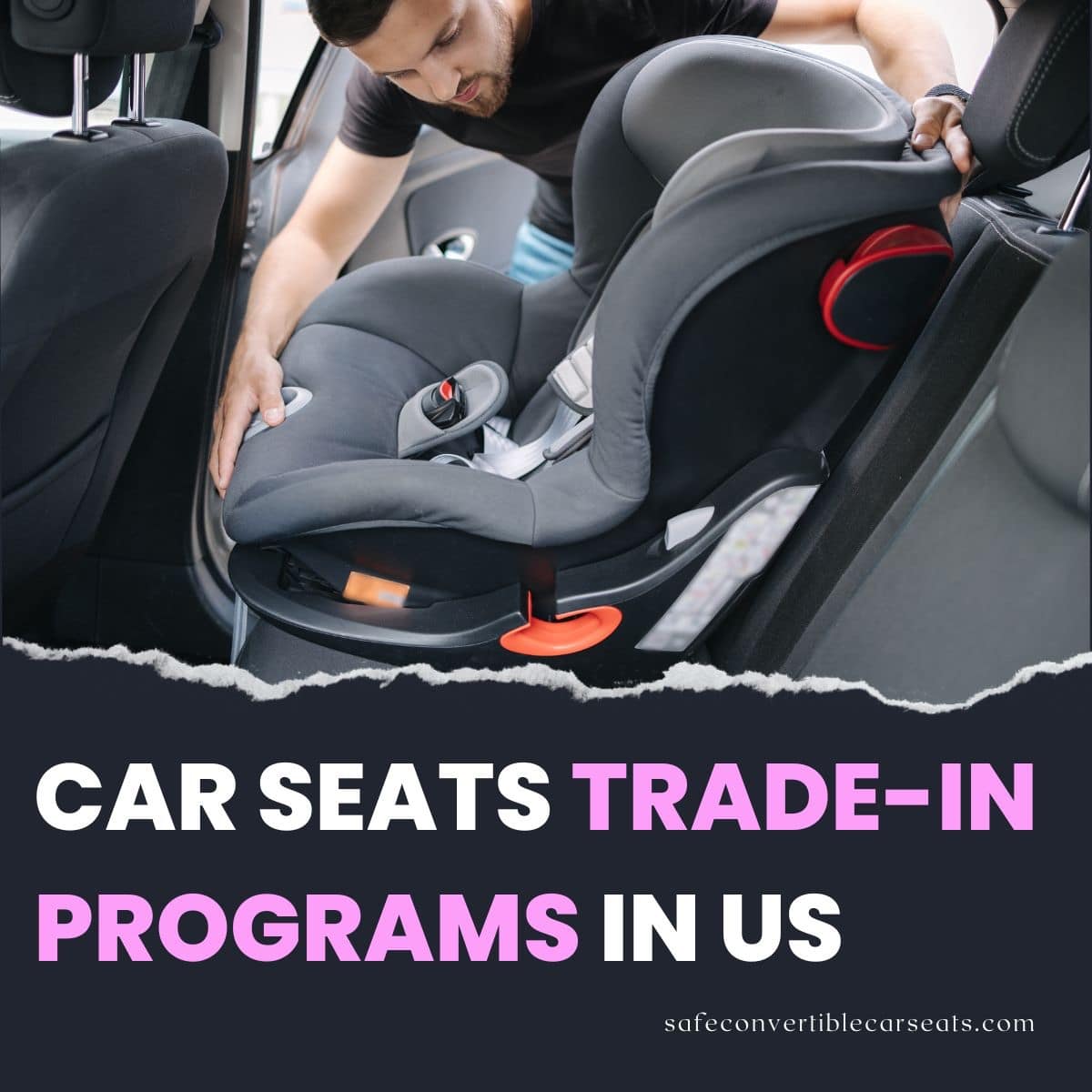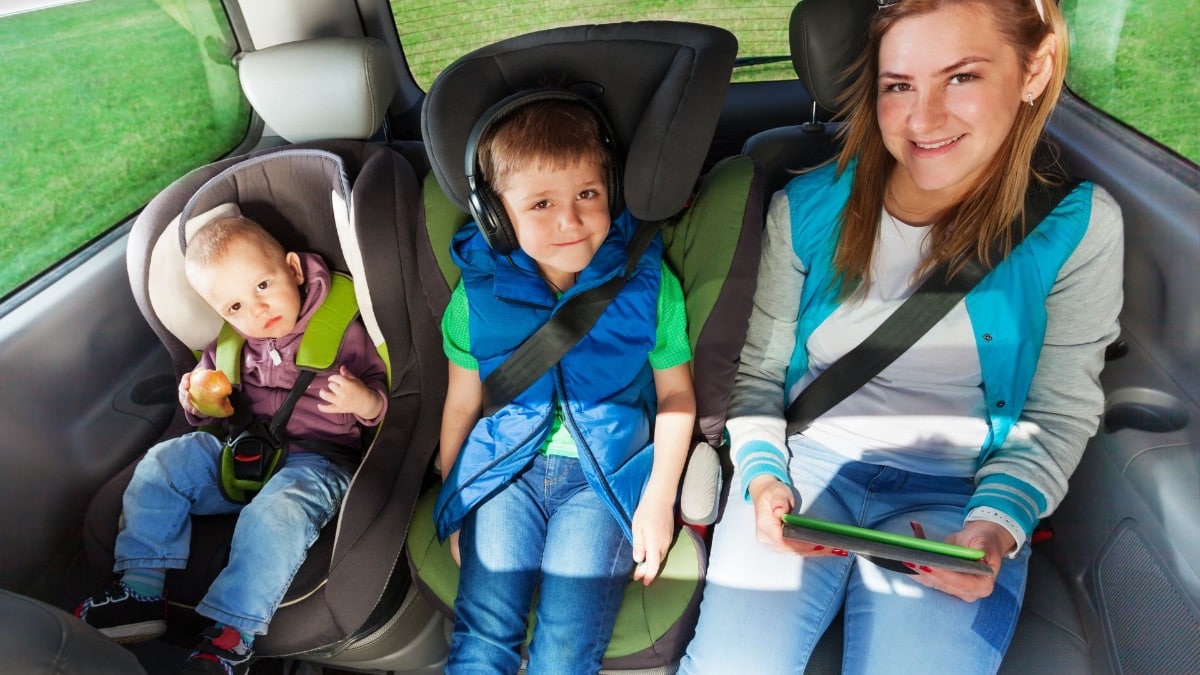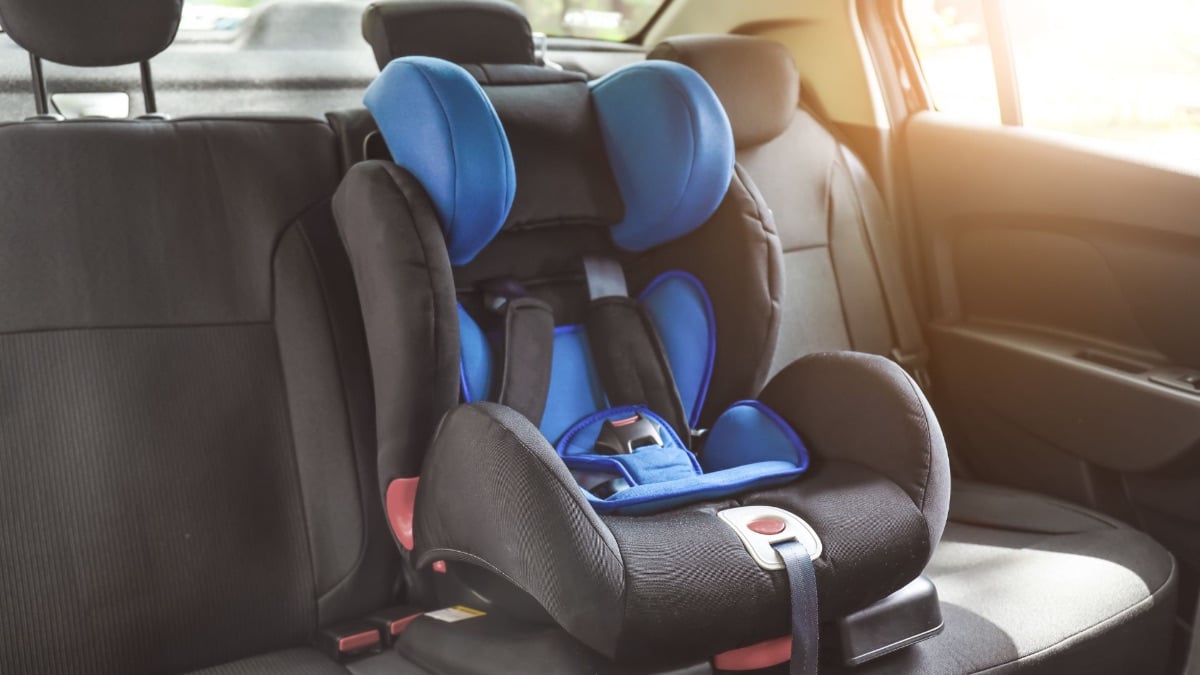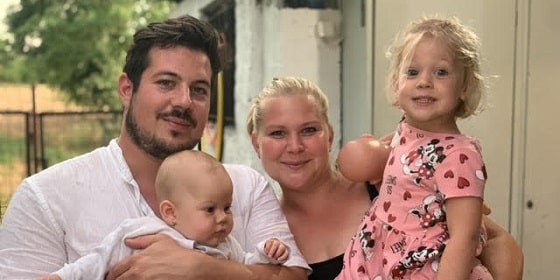Last Updated: 25th September 2023
This guide offers everything you need to know about car seat trade-in programs in the United States—so you can contribute to your baby's well-being and countless others.
Remember - car crashes are the leading cause of death among children—and most of those children were improperly secured in malfunctioning or broken car seats.
Using car seat trade-in programs means you can make sure the seats you are using are working, and are keeping your kids safe. (Trading in also means the seats can be recycled, so they don't end up on landfills, win win!)
Where to start? That's what our complete guide is for!

Signs Your Car Seat Needs to Go
We all know, sadly, that children grow fast!
As a result, many of the items that kids depend on—clothing, toys, and of course, well-loved car seats—rapidly go from invaluable to completely useless.
Additionally, car seats become valueless—and dangerous—when broken or expired. To that end, learning to recognize when your car seat must go is essential.
Here are the two biggest reasons to trade-in your car seat now:
1. Your Child Has Outgrown It

First, your child outgrows their infant car seat. Then, they outgrow their booster seats. Soon, you are left with old car seats gathering dust in the corner of your house.
It’s important to recognize the signs that your child has matured to the point where their car seat is no longer safe to use.
To that end, here are some of the most important things to consider when determining whether to keep your car seat.
Your child no longer needs their infant car seat when:
- Your child has exceeded the maximum height or weight limit: Remember to weigh and measure your child frequently and compare these metrics to the limits indicated on the seat.
- The top of your child’s head is less than one inch from the top of the car seat: The average baby should switch to a convertible seat between nine months and two years—but the child’s head should never meet the top of the seat.
Your child no longer needs a convertible car seat when:
- They reach four years old: Before four, a baby should always occupy a rear-facing convertible car seat.
- They reach the seat height and weight limit: As with infant seats, it is important to respect the indicated limits.
- The gap between the child’s head and the top shell of the seat is under one inch.
Your child no longer needs a booster seat when:
- They reach 8-12 years old: Although age is a useful indicator, remember to consider other factors before tossing your old booster seat.
- They are tall enough to fit behind the seat belt safely: An excellent way to measure this is by assessing whether your child can keep their back against the seat with knees bent over the edge and feet touching the ground.
2. Unsafe and Expired Car Seats
The second reason you should consider tossing an old car seat is if it is unsafe or expired.
Broken car seats, for example, are often hazardous to your child and should be tossed or repaired immediately.
Your car seat may be unsafe if:
- The webbing is frayed or damaged.
- The plastic structure is cracked, bent, stressed, or flexible.
- The latching system is damaged or bent.
- The polystyrene is cracked or compromised—check to see if it is being held in place by the fabric cover (a sign that it is unsafe).
Expired car seats may also pose a significant danger to your infant or toddler. You can check the expiration date on the white label underneath the seat.
If there is no expiration date, check the date of manufacture (DOM). The seat should be less than 6 years old.
If the date has passed, you must throw the car seat away or risk an accident, injury, or legal implications.
One final note: if you have been in a severe accident, the National Highway Traffic Safety Administration recommends replacing your car seat—even if it doesn’t appear damaged.
What Should You Do With Your Old Car Seat?
When you find out your old car seat isn’t safe or good for your child anymore, you might want to just throw it in a corner or, even worse, in the trash.
Old car seats can really harm the environment and add to the world’s waste problem.
Plus, there are many families who can’t afford car seats and really need them.
So, here are some easy ways to recycle your car seat instead of wasting it.
We have a full article on this topic, so make sure you check it out.
1. Retail Trade-In Programs and Events
Trading in your car seat is a great way to recycle it!
Usually, when you trade in your old car seat, you get coupons, discounts, or other special deals. The place you trade it to will then either donate or recycle the car seat, depending on their program and how good the seat still is.
Target, Walmart, and TerraCycle offer some of the most well-known trade-in programs in the United States, but there are other establishments and events you can frequent to donate your car seat.
Research suggests that car seat trade-in programs have a positive impact on the environment. Additionally, they help to redress economic inequalities that may contribute to adverse outcomes for low-income children.
Donating your car seat to a trade-in program can benefit you, your child, and countless others.
2. Reuse Them
If you have a second child, you can reuse your existing car seat.
Alternatively, you can offer your car seat to a family member or friend. Remember to ensure that the seat is intact and has not reached its expiration date, as you do not want to endanger the recipient.
If you have had the car seat for over six years or it is damaged in any way, you must recycle it or throw it away.
Consumer Reports maintain that reusing car seats is risky for several reasons. These include:
- The seat may be damaged without you knowing it.
- The seat may have been in a previous car accident.
- The new occupant may not be the right size for the seat.
- The seat may have expired.
You never truly know if a seat is damaged, so reusing your old car seat isn’t the safest option.

3. Recycle the Car Seat
Recycling your car seat is a great alternative!
If your car seat is expired or broken, you can take it to a nearby recycling center, give it to a recycling program, or even put it in the recycling bin!
There are also many mail-in programs where you can send your old or broken car seat and get coupons or special deals in return.
Consider the pros and cons of recycling your car seat:
pros | cons |
|---|---|
Car Seat Trade-In Programs - The Best Option
Car seat trade-in programs are far and away the best option—if your cat seat is intact, undamaged, and within the expiration date.
If you can’t trade your car seat in, consider recycling it with one of the recycling programs below.
While some programs only take car seats, others may accept booster seats, high chairs, strollers, and assorted baby gear. In exchange, you may receive coupons or save on select brands.
Consider using one of these programs to contribute to the environment and babies in need.
1. Target Car Seat Trade-In Program
The Target Car Seat Trade-In Program, is one of the country's most popular and widely used.
Since starting the program in 2016, Target has recycled more than 2.1 million car seats, which equals over 32.9 million pounds of materials like polystyrene and fabric webbing.
Target, with the help of its partner, Waste Management, makes sure these materials are recycled and not just thrown away.
Usually, when you trade in car seats at Target, they give you a 20% off coupon for new car seats, strollers, or some baby items.
Target is really working hard to help the world have zero waste in landfills in the U.S. by 2030, and they are doing a great job keeping their promise!
Where Can I Take the Car Seat?
You can bring your old car seat to any Target location across the country.
Most stores participate in the trade-in program, though some small format stores may be exempt. Check the Target website, or contact your local store to learn more.
You will see signage directing you to the drop-off boxes when you arrive at the store. These boxes are often near the Guest Services station or customer service desk.
Target's Event Duration
Target’s car seat trade-in program typically takes place twice a year for two weeks.
The first trade-in event takes place in the springtime, usually in April, while the second takes place in the fall, around September.
In 2023, the Target trade-in program took place from April 16th to April 29th at Target stores across the country.
The 2024 event will be held in April 2024.
To obtain your coupon, simply deliver the car seat and scan the QR code provided. If you run into any problems, an employee will likely be present.
The coupons offered as part of the program typically expire a month from the acquisition.
What Type of Car Seats Does Target Accept?
Target accepts most car seats.
Target’s trade-in program FAQs specify that the company will accept the following:
- Infant car seats
- Convertible car seats
- Car seat bases
- Car seat parts
- Harness or booster car seats
- Expired or damaged seats
2. Walmart Car Seat Trade-In Program
Walmart’s car seat trade-in program is one of the nation’s largest recycling events.
The major corporation partners with TerraCycle, a waste management company that aims to eliminate landfill waste worldwide.
Although the program only ran for two weeks in 2019, the response was so overwhelming that the company ended the event early.
Each donor received a $30 gift card for new car seats, strollers, booster seats, and assorted baby gear.
Although pleased with the results, Walmart is not equipped to handle this volume of donations, so the company has partnered with TerraCycle to offer recurring trade-in programs throughout the year.
For more information on TerraCycle, visit the next section of this article.
Where Can I Take the Car Seat?
Many Walmart stores are part of the car seat trade-in program.
You can check with your local Walmart or call them before you go. Even though many stores are part of the program, some might not be, so it’s good to know before you bring your car seat there.
When you get to the store, just take your used car seat to the customer service desk.
Before, people have gotten $30 Walmart gift cards for bringing in their old car seats, strollers, and other baby items.
Walmart Event Duration
The 2019 Walmart trade-in program lasted two weeks.
It was initially to take place from September 16th to September 30th, but the company halted the event on September 21st due to the unexpected volume of donations.
As a result, Walmart now works with TerraCycle to provide ongoing car seat recycling services.
What Type of Car Seats Does Walmart Accept?
Walmart accepts most brands and types of car seats, including infant car seats, booster seats, toddler car seats, convertible car seats, and more.
Walmart’s current program remains open to most varieties of seats, though costs may vary depending on the particular brand.
3. TerraCycle Car Seat Program
TerraCycle is a nationwide waste management company that aims to reduce global waste and eliminate plastic from landfills.
This company has partnered with many multinational corporations to offer recycling options for needy families.
TerraCycle partnered with Walmart in 2019 for their car seat trade-in event and has since worked with the significant conglomerate to bring easy, accessible recycling to new parents everywhere.
Currently, you can trade in your car seat with the Baby Gear Zero Waste Box.
This program allows you to order boxes of varying sizes, fill them with your baby gear, and send them back to TerraCycle to be recycled.
This program requires you to pay for the box, which can range between $116 and $217, depending on its size.
Where Can I Take the Car Seat?
If you choose to participate in TerraCycle’s trade-in program, you may simply place your baby gear in a box and mail it to TerraCycle using the instructions on the website.
Alternatively, TerraCycle partners with certain businesses and brands. You may even be able to bring your car seat to a given location, such as a school or facility.
This program is the most flexible since it operates annually and around the country.
Terracycle Event Duration
TerraCycle’s ongoing trade-in program allows you to recycle your used baby gear anytime!
That does not mean you have to drive to a given location—you can assemble your box at home and ship it to TerraCycle through any UPS store.
What Type of Seats Does TerraCycle Accept?
Accepts Century brand products. This program is free, but you cannot use it if another brand produces your car seat or baby gear.
The Baby Gear Zero Waste Box is open to all brands and car seat types. You can recycle assorted baby gear—like strollers, bassinets, diaper pails, and cribs.
You cannot send:
- Baby diapers
- Electronics
- Baby clothing
- Baby-related waste
- Lithium-ion batteries
- Fabric
- Baby toys
4. Clek Car Seat Program
Clek is a car seat company that caters to millions of families around the world.
They've partnered with Carseatrecycling.com to recycle as many car seats as possible.
The Clek car seat program is a partnership between Clek and the waste management company CarSeatRecycling.com.
Since starting the program in 2013, the company has gathered millions of car seats, stopping more waste from filling up landfills.
You can recycle baby, convertible, or booster seats through this program, and it’s pretty easy to do.
- Just buy a recycling kit from carseatrecycling.com. It comes with a prepaid shipping label and a choice of 10% off purchases of $100 or more or $10 off purchases of $40 or more.
- Pack the car seat in the given bag or box and take it to a UPS store.
- Use your coupon at any Clek store or online!
Where Can I Take the Car Seat?
With the Clek program, you can box your car seat and bring it to any UPS store.
This is an advantage for busy families and single parents and can help you save time in your otherwise busy schedule.
Remember to bring the box to a UPS store since other mail carriers do not participate in the program.
Event Duration
The Clek trade-in program is ongoing, so you can ship your car seat anytime and redeem your coupon.
Clek has not stopped accepting car seats since the company launched the program in 2013, so it should remain accessible to all interested.
What Type of Car Seats Does Clek Accept?
The Clek car seat program only accepts Clek-branded products.
The original item must be a car seat, booster, or convertible purchased from Clek since the company does not accept other brands.
Consider using another recycling program if your car seat is not from Clek.
5. Amazon Car Seat Program
Amazon does not offer a car seat trade-in program.
Although the digital marketplace facilitates many sales of car seats, strollers, and other baby gear, it does not, as of yet, offer a car seat recycling option.
However, Amazon does have an electronic device trade-in program.
If your baby is no longer interested in the iPad (doubtful—but always possible) or you are due for a new phone upgrade, you can recycle your old electronics through Amazon.
With Amazon’s trade-in program, you simply answer a few questions, send in your old device, and receive an Amazon gift card equal to the appraised value of your recycled item.
Although Amazon does not yet provide a car seat trade-in program, the company may do so in the future, so remember to check in frequently.
Final Thoughts
Old car seats are a big problem for the environment and can make global inequalities worse.
Luckily, you can help make the world a better place by trading in your used car seat for recycling.
By doing this, you’re helping our planet and future generations—including your own child!
Try TerraCycle’s simple ship-in program or go to your local Target or Walmart to recycle your car seat during a trade-in event.
The children of the world thank you!

Growing up I was a carefree male going about life like there was no tomorrow. Naturally, I ‘grew’ up, settled down and started a family.

Going from an independent carefree male to a family man was somewhat of a U-turn and required a lot of learning. Luckily for me, my wife works in education and has always been the shining light always ahead of me on all factors kids related.
Initially, my wife didn’t have a driving license (luckily this has now changed and it does make life easier), and all things car related were my task. Child locks were the obvious starting point which lead me down a rabbit hole.
So far we have personally tested dozens of convertible car seats and have owned five despite neither of our kids having reached the age of 5! Simply put, a car seat can be great on paper, work great on trying out but can fail on you in real life.
This is why I have put together this website – to help inform and educate you!
Of course, as I mentioned above, at the end of the day your experience will be the best test so I’d love to hear your experiences and feedback in the comments.
To contact me personally, please do so through my contact page.
I look forward to hearing from you!
Peter
P.S. If you click a link on my site and end up buying a car seat on Amazon, I’ll get paid a small commission (or as the Amazon lawyers put it: “As an Amazon Associate I earn from qualifying purchases”)
Leave a Reply